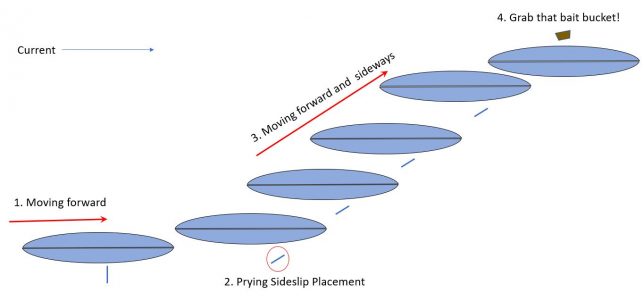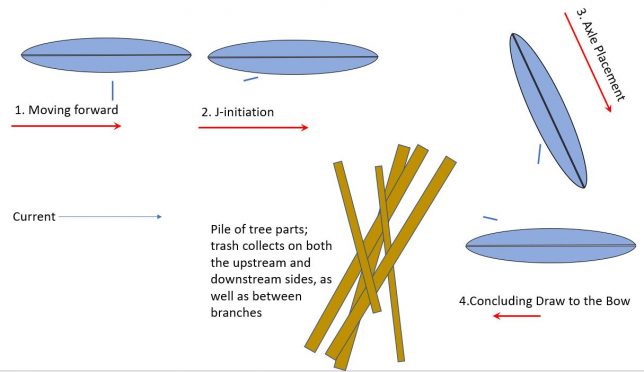FreeStyle Canoe Instructors spend a fair amount of time talking about the Functional facet of FreeStyle Technique. Here’s another perspective on that functionality…
Bear with me for some introductory comments… I spend a lot of time cleaning up my local river, which has been used as an agricultural and industrial dumping ground for the better part of 190 years (Chicago area). When we started cleaning this up, some 20 years ago, there was trash at every turn. Parts of vehicles, including automobiles, pickup trucks, farm implements (some horse-drawn), and semi-trailer trucks were scattered everywhere you could look. Smaller trash, including a lot of fishermen’s litter, buried the few open spaces that remained. Plastic bags were everywhere. Note that cleaning up this mess has been a team effort… more than 150 other volunteers for the local Forest Preserve District have helped for various lengths of time. I remain actively involved, and for the most part, I coordinate the troops, and lead Volunteer Workdays…
Part of that “coordination” effort involves training new volunteers. Paddling skill requirements are not rigorous… if you can keep your end of a canoe upright, and do some basic maneuvering, that’s good enough. It’s a pretty placid river, qualifying as “Flatwater,” but sometimes somewhat more skillful maneuvering is helpful… and that’s where FreeStyle Techniques come into play. I teach these skills, not in a “classroom” situation, but as needed, while we’re working our way down the river, so people get a good grasp of when they might use these skills. People do catch on…
Sideslips are handy maneuvers for slipping away from a log or rock, or towards a dock, but they work equally well when approaching a piece of trash that you want to pick up:

It’s not unusual to find piles of tree trunks and branches piled against the riverbank. These collect trash and other debris, but water passes through them easily. Bits of trash can be reached from upstream and downstream sides of the pile of branches, and often collects between the branches. Turning parallel to the log pile on the upstream side is easy enough, but approaching the downstream side presents a different challenge. I find an Axle or Cross-Axle to be an effective way to place your canoe where you want it to be:

Note that I call this an Axle, not an Eddy Turn. This is because there is so little current that there’s not often an actual eddy to turn into! Remember, I’m in the flatlands…
Imagine this situation, which happened several years ago, when I was still learning basic FS techniques. There was a group of us floating down the river, picking up trash as we paddled. I was paddling solo in a 16 foot tandem, alongside a colleague who was also paddling solo in a 16 foot tandem. He was on my left, and we were talking about something or other. I spotted a piece of trash on the left river bank up ahead… being greedy, I executed a couple of quick, strong forward strokes to get ahead of my friend, then turned the canoe toward the piece of trash. As I approached the shoreline, a bit upstream of the piece of trash, I executed a Cross Christie, which turned my boat around so I was facing upstream, but parked the canoe nicely against the river bank, right where the trash was. I reached over the gunnel, and recovered the piece of trash. Note this was NOT a Competition Level maneuver; the rail was nowhere near the water. But it was just the right thing to do, to place me and my canoe where we needed to be; that’s FUNCTIONAL!
As I prepared to get myself back out into the current, my friend said something like “Are you doing that FreeStyle stuff again?” I had to think… how had I gotten myself into the river bank? But I had to admit, yes, I was “doing that FreeStyle stuff again.” My friend then commented, “Did you remember you have a truck tire across your stern gunnels?”
I may have said something colorful, but no, I had not remembered the tire… and fortunately, I didn’t drop the tire back into the river!
Now, I’m not claiming that everybody on this River Stewardship crew can execute a Cross Christie; chances are good that I’m the only one. But a few of the basic building blocks of FreeStyle have proven quite useful, for the folks who have learned them. And if the bow paddler places a hanging draw, and the stern paddler knows to do some sweep strokes, paddling just gets easier. Folks who have been volunteering for more than a year or so can get around corners without flailing paddles, which saves them a lot of energy and frustration. That’s FUNCTIONAL FreeStyle! And most of the people doing this have no idea they’re executing FreeStyle Maneuvers… they’ve just learned some interesting canoe techniques…